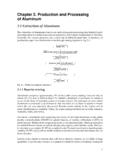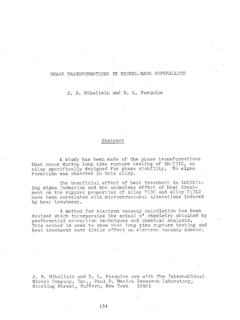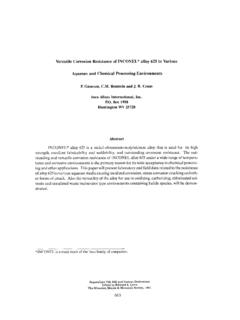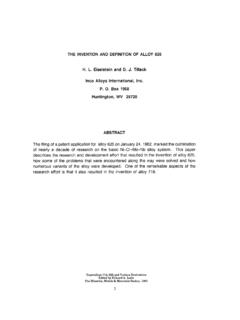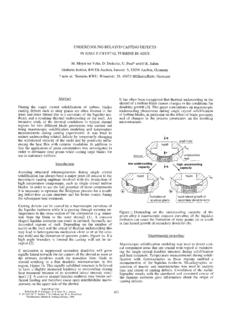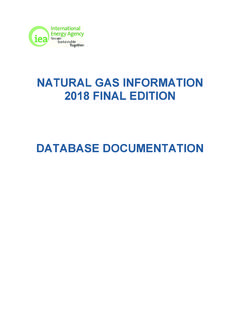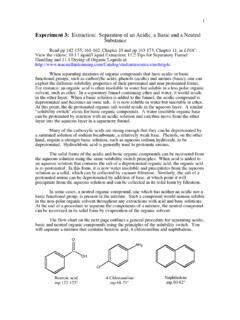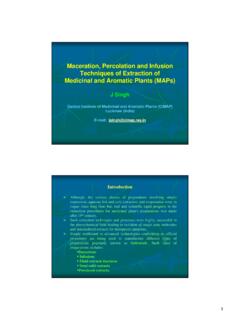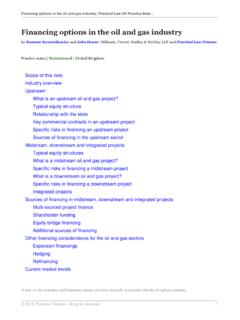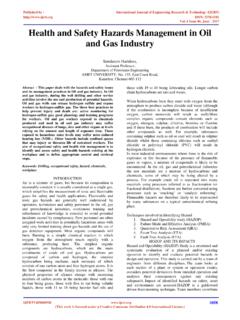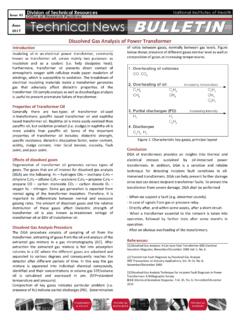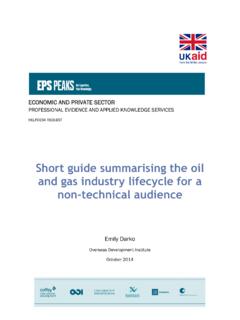Transcription of Chapter 2. Production and Processing of Aluminum
1 7 Chapter 2. Production and Processingof extraction of AluminumThe extraction of Aluminum from its ore and subsequent Processing into finished prod-ucts takes place in a series of successive operations, each largely independent of the the various processes are carried out at different plant sites. A summary ofproduction steps from the bauxite mine through casting is given in Fig. Bauxite miningAluminum comprises approximately 8% of the earth s crust, making it second only tosilicon ( ). Iron is third at about 5%. Metallic Aluminum is not found in nature; itoccurs in the form of hydrated oxides or silicates (clays). The principal ore from whichaluminum is extracted is called bauxite after the town of Les Baux in southern Francewhere the ore was originally discovered.
2 Bauxite occurs mainly in the tropics and insome Mediterranean countries. Today, the main mining locations are in Latin America,Australia, India, and is a weathered rock containing two forms of hydrated Aluminum oxide, eithermostly a monohydrate AlO(OH) in caustic bauxite, or mostly a trihydrate Al(OH)3 inlateric bauxite. Besides these compounds, bauxite contains iron oxide, which usually givesit a reddish-brown colour, as well as silicates (clay, quartz) and titanium oxide. The crys-tal structure also contains 12 20% by weight of water. Tropical monohydrate bauxite gradesyielding 35 55% Al2O3 will no doubt continue to be the most favored Aluminum ores formany rocks similar to bauxite, but with lower alumina content, are available in largequantities. Clays became a source of alumina to a limited extent in Germany during theFig.
3 : Production steps for World War. In addition, many other types of rock contain considerable amountsof alumina, such as kaolin, nepheline, andalusite, leucite, labradorite, and alunite. Theformer Soviet Union exploited such ores to maintain partial autonomy, but these oresplay no significant role in today s Aluminum Production . Chapter 16 will show that theworld s bauxite supplies are guaranteed into the distant The alumina plantThe starting material for electrolytic smelting of Aluminum is pure, anhydrous alumi-num oxide (Al2O3) called alumina. In the Western World, the Bayer1 process, invented inthe 19th century, is by far the most important process used in the Production of alumi-num oxide from bauxite. The process has been refined and improved since its shows that the Production of alumina is a complex chemical process.
4 The alu-mina content of bauxite ores varies from one deposit to another, and methods of treat-ment differ accordingly (see ). This means that each alumina plant is almost tailor-made to suit a particular bauxite. The processes are nevertheless basically similar, and ageneral description is given in the following. The bauxite from the mine is crushed andground. It is then mixed with a solution of caustic soda and pumped into large auto-claves. There, under pressure and at a temperature of 110 270 C, the alumina containedin the ore is dissolved to form sodium aluminate. The silica in the bauxite reacts andprecipitates from solution as sodium- Aluminum -silicate. Iron and titanium oxide and otherimpurities are not affected chemically, and being solid, settle out of solution.
5 This wastematerial, known as red mud, is separated from the sodium aluminate solution, washedto recover the caustic soda, and then pumped to disposal disposal of red mud can present an environmental problem simply because there isso much of it. From a few alumina plants, red mud is deposited on the sea bed understrictly controlled conditions. One very common method of disposal is to contain themud in an area surrounded by dikes. After an interval of some years, these ponded areascan be recultivated to eliminate visual pollution. Although a great deal of effort hasbeen expended on finding and developing various uses for red mud, no bulk applicationof commercial value has yet been the weak soda washed out of the red mud to the sodium aluminate solutiondilutes it and cools it to about 100 C.
6 With stirring and cooling to 60 C, Aluminum hy-droxide Al(OH)3 (hydrargillite) precipitates. Seeding the liquor with crystals from a pre-vious cycle helps to control precipitation. Vacuum filters separate the hydroxide precipi-tate, which is then washed with pure water. Calcination in rotary kilns or in fluidizedbeds at 1100 C to 1300 C finally converts the hydroxide to a dry, white powder. Thispowder is technical purity alumina, containing as impurities at most SiO2, Fe2O3, and grade of the alumina (particle size, - and -Al2O3 content) can be influenced byprecipitation and calcining conditions, and it is usual to differentiate between two maingrades, floury alumina, which is highly calcined and contains mostly -Al2O3, and sandy alumina, which calcined to a lesser degree with mainly -Al2O3 in the hydrated1 Named after the Austrian The sandy alumina has a large, active surface area, which makes it suitable for usein dry scrubber systems for fluoride abatement at Aluminum reduction plants.
7 There is aclear trend toward the Production of increased quantities of sandy Russia, due to a lack of bauxite, a process using nepheline as feed-stock has been usedto produce alumina. Essentially the technique consists of sintering a nepheline ore, orconcentrate, with limestone. The resultant sinter-cake consists of sodium and potassiumaluminates and dicalcium silicate. This material is crushed, ground, and leached. Afterleaching, the aluminate liquor is desilicated and decomposed by carbonation. Aluminahydrate is separated from the liquor and calcined to obtain alumina. After evaporationand crystallization, the carbonate liquor yields soda and potash. These are centrifuged,dried, and packed for shipment. Limestone is added to the slime from sinter-leaching toFig. : Schematic of the Bayer Portland cement in a second calcination step.
8 Processing about 4 tonnes ofnepheline ore yields 1 tonne of alumina, 9 11 tonnes of cement, tonnes of sodaash, and tonnes of to the grade of the bauxite ore, 2 3 tonnes of ore yield one tonne of aluminaand about one tonne of red mud (dry weight). When designing an alumina plant, factorsother than the type of bauxite ore to be used as feed material and the form of alumina tobe produced have to be taken into consideration. A high silica content of the bauxite isundesirable because insoluble sodium- Aluminum -silicate will form, causing losses of caus-tic soda and alumina which increases input material costs. Energy consumption is an-other consideration. The economical operation of the Bayer process requires the rationaluse of energy for steam generation and calcining. Inexpensive fuel is desirable becausethe process needs a large amount of thermal energy.
9 The end product of the aluminaplant is a dry white powder that is the feedstock for Aluminum Primary Aluminum ProductionThroughout the world, primary Aluminum is still produced by the electrolysis of alu-mina in molten fluoride salt. This is, in essence, the process that Hall and H roult in-vented, and which is named after them, but its efficiency has been significantly improvedover the years. The electrolysis plant the Aluminum smelter needs large amounts ofelectrical energy. Therefore, besides good bulk transport facilities, abundant inexpensiveelectric power is essential. Because hydroelectric power is a relatively inexpensive andclean source of energy, Aluminum smelters are mostly built in countries with readily avail-able hydroelectric power, such as Canada, Norway, Venezuela, and Brazil, or in countrieswith abundant deposits of low-grade coal such as Australia or the Republic of SouthAfrica (RSA).
10 Furthermore, the same regions lack other local industry to use this energy,and it is impracticable to transport electric power over very long distances to the indus-trialized regions that could use it. Considering their large energy consumption, alumi-num smelters are major customers that guarantee a stable base load and, thereby, help toreduce their power suppliers unit costs. At present, hydroelectric sources produce thepower for about two-thirds of world Aluminum Production , although placing a smelternext to a nuclear power plant can also be economically attractive, as at Dunkerque inFrance. Fig. shows an Aluminum smelter with its long potrooms and tall The electrolysis process2In the Hall-H roult process, the electrolyte is molten cryolite (Na3 AlF6) in which 2 8% ofalumina (Al2O3) is dissolved.
